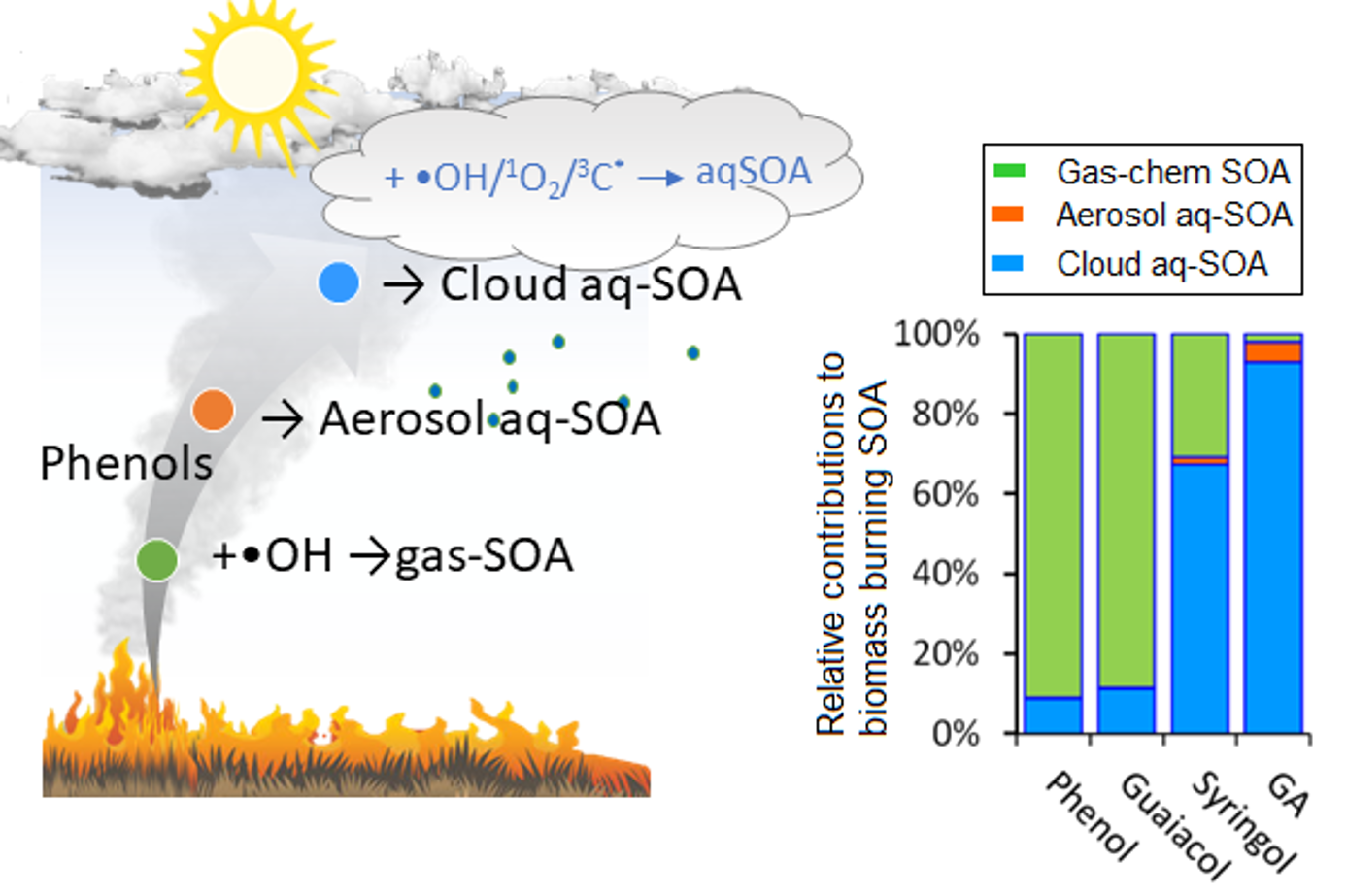Biomass burning gases react within clouds, forming secondary organic aerosols
Submitter
Ovchinnikov, Mikhail — Pacific Northwest National Laboratory
Shrivastava, Manishkumar — Pacific Northwest National Laboratory
Area of Research
Aerosol Processes
Journal Reference
Zhang J, M Shrivastava, L Ma, W Jiang, C Anastasio, Q Zhang, and A Zelenyuk. 2024. "Modeling Novel Aqueous Particle and Cloud Chemistry Processes of Biomass Burning Phenols and their Potential to Form Secondary Organic Aerosols." 58(8), 10.1021/acs.est.3c07762.
Science

Phenols (organic gases) emitted from biomass burning photochemically react in gas-phase, aqueous aerosols, and clouds forming secondary organic aerosols (SOA). Cloud chemistry with aqueous-phase oxidants 3C* and (OH) dominates SOA formation for highly soluble and reactive gases like syringol and guaiacol acetone (GA), while gas-phase reactions with OH radicals dominates SOA formed by less soluble phenols. Image from journal.
Thousands of tiny particles in the atmosphere unseen by the naked eye scatter and absorb solar radiation and seed clouds. A lot of these particles are not directly emitted but are formed by reactions of gases with atmospheric oxidants in multiple phases, including gas-phase and liquid water contained in clouds and other particles. Organic gases, such as phenols emitted in wildfires, could also be taken up by clouds and subsequently react with cloud water in the presence of sunlight-forming secondary organic aerosols (SOA). However, a quantitative understanding of cloud chemistry-forming SOA is limited due to the complexity of their liquid-phase reactions and challenges in measurements. Researchers developed a stand-alone box model to predict aqueous and cloud chemistry of biomass-burning phenols based on laboratory measurements. They found that in cloudy environments, the cloud chemistry of soluble and reactive organic gases like phenols is likely a dominant source of SOA, which is overlooked in climate models.
Impact
As biomass-burning emissions with organic gases and aerosols are transported in the atmosphere, they encounter clouds and undergo aqueous chemistry. Researchers showed that this cloud chemistry could be a major source of SOA in cloudy environments. Neglecting this process has limited our understanding of aerosol impacts on the Earth’s energy balance, clouds, and climate change. In addition, computationally efficient treatments of cloud chemistry are needed for representing it in three-dimensional models. Researchers parameterized and optimized this complex chemistry so that it is amenable for representation in regional and global Earth system models. In the future, they will include cloud chemistry of biomass-burning organic gases in Earth system models, which is expected to fill a major gap in the process understanding of SOA and its impacts on clouds and the Earth’s radiation budget.
Summary
Wildfires continue to increase in frequency and severity, transporting smoke for thousands of miles. The smoke contains soluble organic gases. The reactions of these gases that form aqueous-phase SOA in aerosols and clouds might be important. So far, a quantitative and predictive understanding of the cloud chemistry of biomass-burning organic gases has been missing. Using mechanisms derived from laboratory measurements, researchers simulated the multiphase chemistry of water-soluble organic gases emitted by biomass burning that includes their dissolution within aerosol and cloud liquid water followed by their aqueous-phase reactions to form SOA. Within cloud layers, they found that highly soluble and reactive multifunctional phenols are almost entirely dissolved and react in cloud water, causing SOA formation that greatly exceeds their previously known gas-phase chemistry. Even near the surface in the absence of clouds, these highly soluble phenols form significant amounts of SOA in aqueous aerosols because they can be easily dissolved in aerosol liquid water and are available for aqueous aerosol chemistry. This research is expected to open new frontiers in the understanding of how cloud chemistry increases SOA loadings in the atmosphere and its ability to seed clouds and to scatter and absorb the sun’s radiation. In addition, this work will aid in the design of laboratory-based cloud chamber measurements that aim to understand how SOA cloud chemistry causes detectable changes in cloud droplet residuals and aerosols that serve as cloud condensation nuclei.
Keep up with the Atmospheric Observer
Updates on ARM news, events, and opportunities delivered to your inbox
ARM User Profile
ARM welcomes users from all institutions and nations. A free ARM user account is needed to access ARM data.


















